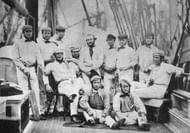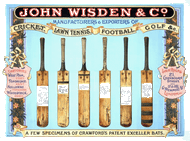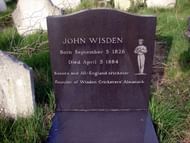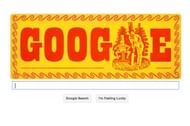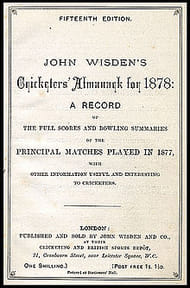
The Bible of Cricket
“Nothing captures the spirit of cricket quite like its 150-year-old annual”
- Matthew Engel
If you follow cricket and know the ABCs of it, you must be aware of ‘Wisden Cricket Almanack’, popularly known as just ‘Wisden’ or ‘The Bible of Cricket’.
It is world’s most famous reference book published yearly in United Kingdom.
It is a tiny 1500 paged sports journal with bright yellow hardback cover, that consists of various cricket articles from around the globe, coverage of ‘Wisden Cricketers of The Year Awards’, extensive coverage of every single first class match of English cricket, coverage of International cricket events, reviews of other publications on cricket and a unique almanack(directory) of all the scheduling of cricket matches for next seven years and index of unusual cricketing events that happened in the past year.
It was founded in 1864 by an English cricketer John Wisden to counter Fred Lillywhite's “The Guide to Cricketers”. Its publication has stayed uninterrupted till this date, making it the longest running annual sports reference book in history.
Who Was John Wisden?
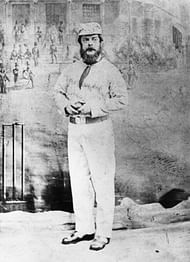
According to Fuller Pilch, John Wisden was the greatest all-rounder of all time. He was a right-arm fast bowler who could bat decently and played the English County in mid 1800s.
One can hardly disagree with Pilch about Wisden after having a look at the latter’s records.
186 first class matches he played as a part of Middlesex, Kent and Sussex. (3 matches for Middlesex, 1 for Kent and rest 182 for Sussex). In those 186 matches, he picked up 1109 wickets at an average of 6.66! During his entire career, his economy was 1.83 and rate of picking up wickets was at every 21.8 runs.
Sounds unbelievable, right? There is more.
111 times he took 5 wickets in an inning and 33 times he took 10 wickets in a match!
His greatest feat remains the greatest bowling performance ever though, when playing for North against the South at the Lord’s; he clean bowled all the 10 batsmen in an innings, bowling from Pavilion end (10/58).
He remains the only bowler to achieve this perfect feat in any first class game till date.
He scored 4140 runs at an average of 14.12 that included 2 centuries and 9 fifties with a high score of 148.
He was also an occasional wicket keeper and held 169 catches during his career.
Early Life And Career
John Wisden was born to a small builder in Brighton named William in 1826.
When he was still a boy, his father died and he went to live as a pot-boy with legendary wicket keeper Tom Box. With him he began to learn his cricket. Despite the struggles, at the age of 19, in 1845 he was chosen to play for Sussex against Kent.
His first appearance at Lord's came in 1846 when Sussex played their yearly game against M.C.C. From 1846 to 1863 Wisden was a regular for Sussex.
According to H. S. Altham, the author of ‘History of Cricket’, he was a mainstay of a team which could almost claim the county ascendancy during the interregnum between the superiority of Kent and the revival of Surrey at the newly opened Kennington Oval.
At 5’6” Wisden, according to Athlam was perhaps the smallest fast bowler to make such history in county cricket.
He became popular as ‘The Little Wonder’, a title given to him by Bob Thomas, a famous umpire then, and batsmen were soon to fear his fast and breathtaking deliveries.
In 1852 he took over as a professional bowling teacher at Harrow School, where the teaching of cricket was in the hands of Frederick Ponsonby, afterwards the 6th Earl of Bessborough. He continued his post till 1855. The accuracy of Wisden's bowling was of great value for the entire coaching process.
It didn’t surprise anyone, when the school itself recognised the centenary and the Head Master accepted a John Wisden Prize of a bat and a ball to be awarded annually to the boy with the best bowling analysis.
An English Player and a rebel
In 1846, Wisden was requested to join the ‘All-England Eleven’, founded and led by William Clarke, which played a great part in popularising and raising the standard of cricket.
The team travelled all across England and, played against 18's, 20's and 22's thus, establishing the notion of a ‘professional cricketer’ as a man with some prospect for the career.
Clarke was a hardliner, and soon several of his teammates rebelled against him due to his autocracies.
Wisden was the leader of this rebel group and started a rival organisation called the United England Eleven along with a fellow fast bowler Dean. John Lillywhite, Adams and Jimmy Grundy joined them, and in August 1852 they played their first match, at Southampton, against ‘Twenty Gentlemen of Hampshire’.
For the next decade or so, English professional cricket was divided into two camps, with Wisden's United England Eleven attracting many great players of the time.
After Clarke died in 1856, George Parr took over the All-England Eleven. In 1859, Parr and Wisden became joint proprietors of a cricket ground at Leamington, and brought two rival XIs together in a tour to the United States and Canada. This tour set the tone for several other visits in future for various English sides hence making Wisden as a prime contributor to the history of English Cricket.
Wisden, the Proprietor
‘The House of Wisden’ was in making, nine years before the tour to Canada.
John Wisden, already in partnership with George Parr of the Leamington ground, started ‘Parr and Wisden's Cricket Club’ in 1850, with which he associated the business of sports outfits.
Five years later he moved to London and opened a Cricket and Cigar depot in Coventry Street of the Haymarket. There, he became the well-to-do, chivalrous proprietor of a West End cricket store, beaming with watch and chain of gold.
After his death in 1884, his business was passed to his manager, Henry Luff who took the enterprise to new heights, amalgamating several other sports gears and outfits with cricket.
In 1911, it received a ‘Royal Warrant’ as "Athletic Outfitters to the King".
In 1920, its factory was established at Penshurst in collaboration with Kent firm of ‘Duke and sons’. The enterprise went into receivership in 1939 due to lack of enough funds, and was acquired by the Co-operative society. In 1970, they further sold it to Grays of Cambridge.
Grays stopped using ‘Wisden’ as a brand, but re-established ‘John Wisden & Co’ as the publisher of the Cricketers' Almanack. It is now an imprint of Wisden's owner, Bloomsbury Publishing Plc.
Death
Wisden died of cancer at a relatively young age of 57 in his flat at Cranbourn Street. His cemetery is situated at Brompton, London.
Legacy
Wisden is a household name wherever cricket is played, or indeed spoken about.
He became synonymous to the game of cricket itself via his most timeless immortal creation that is the Cricket’s Almanack. It is a privileged dream for every single cricketer to win a Wisden annual award or to be featured on the ‘Bible of Cricket’.
John Wisden as a player was phenomenal but his legacy as the creator of the greatest sports annual in the history made him immortal.
Looking for fast live cricket scores? Download CricRocket and get fast score updates, top-notch commentary in-depth match stats & much more! 🚀☄️
